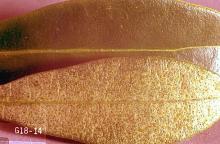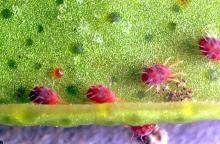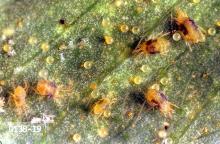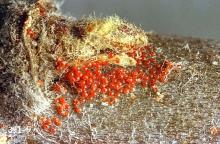Includes
European red mite (Panonychus ulmi)
McDaniel spider mite (Tetranychus mcdanieli)
Twospotted spider mite (Tetranychus urticae)
For mite identification, see:
Field Characteristics of Fruit-Tree-Attacking Spider Mites in the Pacific Northwest
Pest description and crop damage Several species of mites can cause damage in tree fruits. The principal mite pests of cherries include the European red mite and the twospotted spider mite. Appearance of these mites varies with the species, although all are very small, 0.02 inch or smaller. Female European red mites are round with red bodies; males are yellowish-red. Twospotted mites are oval and yellowish-brown or green with distinctive black spots on the body. Mites damage fruit indirectly by feeding on leaves, which causes stippling, bronzing, and possibly leaf drop. The reduction in photosynthesis causes loss of tree vigor and yield.
Biology and life history European red mites overwinter as eggs on smaller branches and fruit spurs. They hatch at pink stage and commence feeding. There are six to seven generations per year. Twospotted spider mites overwinter as adult females under bark or in ground cover. They become active in the spring. There may be eight to ten overlapping generations per year.
Pest monitoring Check the leaves for mites and webbing and observe the number of pest and predator mites. Sufficient control usually is achieved by midsummer by natural enemies.
Management-biological control
Spider mite populations are held down by cool, wet conditions early in the season. Considerable natural control is provided by lady beetles (Stethorus spp.) and minute pirate bugs (Orius tristicolor). Predatory mites such as Typhlodromus spp. or Neoseiulus fallacis (syn. Amblyseius fallacis) are also effective at managing populations of spider mites and may be purchased.
Management-cultural control
Spider mite infestations are favored by dry, dusty conditions, so avoid creating these conditions and/or stressing the plants. The use of cover crops also reduces dust and mite problems. Broadleaf weeds like mallow, bindweed, white clover, and knotweed enhance mite numbers. Suppression of these weeds with cultivation or grasses may reduce mite numbers. Water trees properly, as drought-stressed trees are more susceptible. Avoid excessive nitrogen applications, as this encourages mites.
Home orchardists: Mites may be washed from the tree with a strong stream of water.
Management-chemical control: HOME USE
Dormant-season spray
Apply sprays using enough water to cover the entire tree thoroughly including small limbs. Apply only during dormant or delayed-dormant period.
- horticultural mineral oil (European red mite only)-Some formulations are OMRI-listed for organic use.
Growing-season spray
- azadirachtin (neem oil)-Some formulations are OMRI-listed for organic use.
- carbaryl-Highly toxic to bees.
- gamma-cyhalothrin-Highly toxic to bees.
- insecticidal soap-May require several applications. Complete coverage, especially of undersides of leaves, is essential. Apply April to May. Some formulations are OMRI-listed for organic use.
- lambda-cyhalothrin -Highly toxic to bees.
- malathion-Highly toxic to bees.
- plant-derived essential oils-Some have shown efficacy against spider mites. Some formulations are OMRI-listed for organic use.
- pyrethrins-Some formulations are OMRI-listed for organic use. Highly toxic to bees.
- sulfur-Some formulations are OMRI-listed for organic use.
Management-chemical control: COMMERCIAL USE
Dormant-season spray
- diazinon (Diazinon AG500) at 4 pints/A + horticultural mineral oil (rates vary; see product label). REI 4 days. Do not exceed one dormant application of diazinon per season.
- horticultural mineral oil-Rates vary; check product label. REI varies; check product label. Some formulations are OMRI-listed for organic use.
- pyriproxyfen (Esteem 35WP) at 4 to 5 oz/A. May be mixed with a horticultural mineral oil (rates vary; check product label). REI 12 hr. Pyriproxyfen is a growth regulator with activity toward egg and immature stages only. Under heavy scale pressure, use the higher rate. Do not exceed more than 3 application per season.
Growing-season sprays
- bifenazate (Acramite 50WS) at 0.75 to 1 lb/A. REI 12 hr. PHI 3 days. Use only once per season.
- clofentezine (Apollo SC) at 4 to 8 fl oz/A. REI 12 hr. PHI 21 days. Do not exceed one application per season. Must be applied early in the season when the mite population is predominantly in the egg stage.
- etoxazole (Zeal WSP) at 2 to 3 oz/A. REI 12 hr. PHI 7 days. Use only once per season.
- fenbutatin-oxide (Vendex 50WP) at 1.5 to 3 lb/A. REI 2 days. PHI 14 days. Do not exceed two applications or 4.5 lb/A/year.
- hexythiazox (Savey 50DF) at 3 to 6 oz/A. REI 12 hr. PHI 28 days. Does not significantly control adult rust mites. Apply at first sign of egg deposition before adult mites build up. Apply only one hexythiazox product per season.
- horticultural mineral oil-Rates vary; check product label. REI varies; check product label. Necrotic foliage may result if applied within 2 weeks of any sulfur application. Some formulations are OMRI-listed for organic use.
- spirodiclofen (Envidor 2SC) at 16 to 18 fl oz/A. REI 12 hr. PHI 7 days. Do not exceed one application/year.
Post-harvest spray
- fenazaquin (Magister) at 32 to 36 fl oz/A. REI 12 hr. PHI 3 days. Do not exceed one application per season.
- propargite (Omite 30WS) at 6 lb/A. REI 2 days. No PHI listed. Do not exceed two applications per season.
- pyridaben (Nexter) at 10.67 oz/A. REI 12 hr. PHI 300 days. Do not exceed two applications per season.
Resistance management Spider mites can develop resistance rapidly to chemical controls. Resistance management techniques include using sampling and pest action thresholds to make spray decisions, using higher thresholds on young, non-bearing trees, and rotating pesticides with different modes of action. Clofentezine, etoxazole, and hexythiazox have the same mode of action as do fenbutatin-oxide and propargite.




